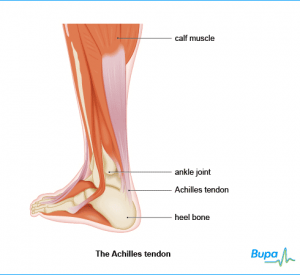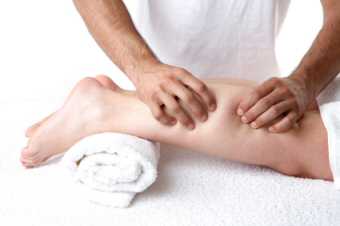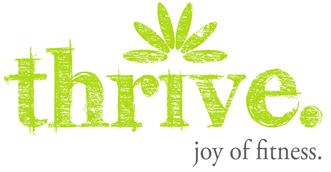A tendon is band of connective tissue that connects muscle to bone. In the case of the Achilles, this tendon joins the calf muscles (gastrocnemius and soleus) to the heel bone (calcaneus). It is the thickest and strongest tendon in the body and can be a runner’s best friend if healthy providing power and strength, or ultimate foe if damaged.
Some trivia …
The name ‘Achilles’ heel’ comes from Greek mythology. Achilles’ mother, the goddess Thetis, received a prophecy of her son’s death so she dipped Achilles in the River Styx in order to make him invulnerable. However, the heel by which she held him was left exposed. During the Trojan War Achilles was struck by a poisoned arrow to his exposed heel which killed him, proving the prophecy to be true.
Friend
As well as being functional in connecting the calf muscles to the ankle, the Achilles tendon is vital for effective running as most of the force generated when you dorsiflex (toe off the ground) is transmitted by the Achilles. This force can be up to three times your body weight and the faster you run, the more strain is put onto the Achilles tendon.
 Think of the Achilles like an elastic band. Thin elastic bands are more flexible but have less power when recoiled. Thick bands are stiffer and require larger forces to stretch but generate a much larger force when recoiled.
Think of the Achilles like an elastic band. Thin elastic bands are more flexible but have less power when recoiled. Thick bands are stiffer and require larger forces to stretch but generate a much larger force when recoiled.
As long distance runners do not rely on muscle strength, they often do not incorporate any weight training into their fitness routines. However, tendon stiffness is increased by this weight training and it can therefore be extremely beneficial for runners; it can not only increase their plyometric (explosive) power but it can reduce the likelihood of injury to the Achilles.
Foe
As a sports massage therapist, problems to the Achilles tendon is one of the more common injuries that I see and, if not addressed quickly, can be a runner’s foe causing a lot of pain with a slow recovery. The main symptoms are pain, stiffness, burning and weakness around the affected area and is frequently worse first thing in the morning before the tendon has had a chance to warm up. Historically, this injury has been referred to as Achilles Tendonitis but as ‘itis’ implies inflammation and the Achilles is often not inflamed, it is now referred to as Achilles Tendinophathy.
For many runners the pain is a niggle and a nuisance but they are able to continue training. Some find that the pain is present at the start of the run but eases throughout the session. It then usually returns more aggressively once the tendon has cooled down after exercise. For some poor people, the pain is so severe it can actually affect everyday activities.
If the pain is tolerable, it is advisable not to stop exercising completely (breathe a sigh of relief here!). Instead, reduce the intensity of the runs avoiding uphill and speed work. It’s worth including cross training and weight training (as mentioned above) into the routine to break up the repetitive heel striking cased by running. If you wear barefoot or minimal running shoes, it’s advisable to stick to traditional trainers until the problem disappears. Stretch out the calf muscles whilst they’re warm after exercise but be careful not to stretch them aggressively as this can aggravate the problem. It’s also worth trying to take smaller strides when running to decrease the impact on the heel.
The majority of cases of Achilles Tendinopathy occurs at the midpoint of the tendon a few inches up from the heel. Some people, however, will experience the pain at the insertion point where the tendon actually attaches to the heel.
Treatment
Eccentric (the lowering part of an exercise when the muscle lengthens out of contraction) strength exercise is highly recommended to strengthen the affected tendon. Select which of these two exercises is relevant for you.
A) Eccentric heel drop for midpoint Achilles Tendinopathy
1) Stand on the edge of a step with your heels hanging over the back of it
2) Putting your weight onto your uninjured side, slowly stand up on to your tip toes (ie plantarflex your feet)
3) Shift the weight onto your injured side and slowly lower the feet below the level of the step
4) Repeat 15 times and do twice a day
You can carry this out with a mix of straight knees and flexed knees. Once the pain is minimal, try carrying out the exercise whilst carrying extra weight (a rucksack is ideal). This will help progress the strength of the tendon.
B) Eccentric heel drop for insertion Achilles Tendinopathy
This exercise is as the midpoint exercise but do it on flat ground rather than on a step. Also, only do it with straight knees.
So for both forms of heel drop, remember to go up on the good leg, come down on the bad leg… and do it slowly!
These eccentric exercises may cause some pain as tendon fibres are mildly damaged. This should be expected and is important as it allows the body to lay down new fibres that are closer in alignment to the healthy collagen in the tendon.
Do not carry out these exercises if the pain is extreme. If this is the case or you are still in pain after 3 months of eccentric strength exercises, visit your doctor for further, more advanced treatment.
If you are suffering from Achilles pain or any muscular niggles and are in need of a sports massage, there’s 15% off sports massage with Thrive. Joy of fitness. on your first booking if you quote ‘Run Through’. Contact Melissa on 07808 174 758 or email [email protected] Melissa will come to your house if you are in South West London or Surrey. For prices, see
Melissa Joy
Sports Massage Therapist

